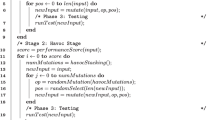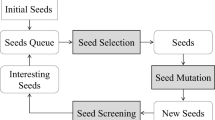Abstract
Fuzzing is known to be one of the most effective techniques to uncover security vulnerabilities of large-scale software systems. During fuzzing, it is crucial to distribute the fuzzing resource appropriately so as to achieve the best fuzzing performance under a limited budget. Existing distribution strategies of American Fuzzy Lop (AFL) based greybox fuzzing focus on increasing coverage blindly without considering the metrics of code regions, thus lacking the insight regarding which region is more likely to be vulnerable and deserves more fuzzing resources. We tackle the above drawback by proposing a vulnerable region-aware greybox fuzzing approach. Specifically, we distribute more fuzzing resources towards regions that are more likely to be vulnerable based on four kinds of code metrics. We implemented the approach as an extension to AFL named RegionFuzz. Large-scale experimental evaluations validate the effectiveness and efficiency of RegionFuzz-11 new bugs including three new CVEs are successfully uncovered by RegionFuzz.
Similar content being viewed by others
Explore related subjects
Discover the latest articles, news and stories from top researchers in related subjects.References
Miller B P, Fredriksen L, So B. An empirical study of the reliability of UNIX utilities. Communications of the ACM, 1990, 33(12): 32-44. DOI: https://doi.org/10.1145/96267.96279.
Li J, Zhao B, Zhang C. Fuzzing: A survey. Cybersecurity, 2018, 1(1): Article No. 6. DOI: 10.1186/s42400-018-0002-y.
Sutton M, Greene A, Amini P. Fuzzing: Brute Force Vulnerability Discovery (1st edition). Addison-Wesley Professional, 2007.
Chen C, Cui B, Ma J, Wu R, Guo J, Liu W. A systematic review of fuzzing techniques. Computers & Security, 2018, 75: 118-137. DOI: https://doi.org/10.1016/j.cose.2018.02.002.
Manès V J M, Han H S, Han C, Cha S K, Egele M, Schwartz E J, Woo M. The art, science, and engineering of fuzzing: A survey. IEEE Trans. Software Engineering. DOI: https://doi.org/10.1109/TSE.2019.2946563.
Devarajan G. Unraveling SCADA protocols: Using sulley fuzzer. In Proc. the DEF CON 15 Hacking Conf., August 2007.
Gascon H, Wressnegger C, Yamaguchi F, Arp D, Rieck K. Pulsar: Stateful black-box fuzzing of proprietary network protocols. In Proc. the 11th International Conference on Security and Privacy in Communication Networks, October 2015, pp.330-347. DOI: https://doi.org/10.1007/978-3-319-28865-918.
Ganesh V, Leek T, Rinard M. Taint-based directed white-box fuzzing. In Proc. the 31st Int. Software Engineering, May 2009, pp.474-484. DOI: https://doi.org/10.1109/ICSE.2009.5070546.
Wang T, Wei T, Gu G, Zou W. TaintScope: A checksumaware directed fuzzing tool for automatic software vulnerability detection. In Proc. the 2010 IEEE Symposium on Security and Privacy, May 2010, pp.497-512. DOI: https://doi.org/10.1109/SP.2010.37.
Stephens N, Grosen J, Salls C, Dutcher A, Wang R, Corbetta J, Shoshitaishvili Y, Kruegel C, Vingna G. Driller: Augmenting fuzzing through selective symbolic execution. In Proc. the 23rd Annual Network and Dis- tributed System Security Symposium, February 2016. DOI: 10.14722/ndss.2016.23368.
Godefroid P, Levin M Y, Molnar D. SAGE: Whitebox fuzzing for security testing. Communications of the ACM, 2012, 55(3): 40-44. DOI: https://doi.org/10.1145/2093548.2093564.
Situ L, Wang L, Li X, Guan L, Zhang W, Liu P. Energy distribution matters in greybox fuzzing. In Proc. the 41st Int. Software Engineering: Companion Proceedings, May 2019, pp.270-271. DOI: https://doi.org/10.1109/ICSE-Companion.2019.00109.
Böhme M, Pham V T, Roychoudhury A. Coveragebased greybox fuzzing as Markov chain. IEEE Trans. Software Engineering, 2017, 45(5): 489-506. DOI: https://doi.org/10.1109/TSE.2017.2785841.
Pham V T, Böhme M, Santosa A E, Caciulescu A R, Roychoudhury A. Smart greybox fuzzing. IEEE Transactions on Software Engineering. DOI: https://doi.org/10.1109/TSE.2019.2941681.
Du X, Chen B, Li Y, Guo J, Zhou Y, Liu Y, Jiang Y. Leopard: Identifying vulnerable code for vulnerability assessment through program metrics. In Proc. the 41st Int. Software Engineering, May 2019, pp.60-71. DOI: https://doi.org/10.1109/ICSE.2019.00024.
Li Y, Su Z, Wang L, Li L. Steering symbolic execution to less traveled paths. ACM SIGPLAN Notices, 2013, 48(10): 19-32. DOI: https://doi.org/10.1145/2544173.2509553.
Wang X, Sun J, Chen Z, Zhang P, Wang J, Lin Y. Towards optimal concolic testing. In Proc. the 40th Int. Conf. Software Engineering, May 2018, pp.291-302. DOI: https://doi.org/10.1145/3180155.3180177.
Inozemtseva L, Holmes R. Coverage is not strongly correlated with test suite effectiveness. In Proc. the 36th Int. Conf. Software Engineering, May 2014, pp.435-445. DOI: https://doi.org/10.1145/2568225.2568271.
Petsios T, Zhao J, Keromytis A D, Jana S. Slow- Fuzz: Automated domain-independent detection of algorithmic complexity vulnerabilities. In Proc. the 2017 ACM SIGSAC Conference on Computer and Communications Security, October 2017, pp.2155-2168. DOI: https://doi.org/10.1145/3133956.3134073.
Lemieux C, Sen K. FairFuzz: A targeted mutation strategy for increasing greybox fuzz testing coverage. In Proc. the 33rd ACM/IEEE Int. Automated Soft- ware Engineering, September 2018, pp.475-485. DOI: https://doi.org/10.1145/3238147.3238176.
Böhme M, Pham V T, Nguyen M D, Roychoudhury A. Directed greybox fuzzing. In Proc. the 2017 ACM SIGSAC Conference on Computer and Communications Security, October 2017, pp.2329-2344. DOI: https://doi.org/10.1145/3133956.3134020.
Gan S, Zhang C, Qin X, Tu X, Li K, Pei Z, Chen Z. CollAFL: Path sensitive fuzzing. In Proc. the 2018 IEEE Symposium on Security and Privacy, May 2018, pp.679-696. DOI: https://doi.org/10.1109/SP.2018.00040.
Chen P, Chen H. Angora: Efficient fuzzing by principled search. In Proc. the 2018 IEEE Symposium on Security and Privacy, May 2018, pp.711-725. DOI: https://doi.org/10.1109/SP.2018.00046.
Dolan-Gavitt B, Hulin P, Kirda E, Lee T, Mambretti A, Robertson W, Ulrich F, Whelan R. LAVA: Large-scale automated vulnerability addition. In Proc. the 2016 IEEE Symposium on Security and Privacy, May 2016, pp.110- 121. DOI: https://doi.org/10.1109/SP.2016.15.
Woo M, Cha S K, Gottlieb S, Brumley D. Scheduling blackbox mutational fuzzing. In Proc. the 2013 ACM SIGSAC Conference on Computer & Communications Security, November 2013, pp.511-522. DOI: https://doi.org/10.1145/2508859.2516736.
Böhme M. STADS: Software testing as species discovery. ACM Transactions on Software Engineering and Method- ology, 2018, 27(2): Article No. 7. DOI: https://doi.org/10.1145/3210309.
Situ L Y, Wang L Z, Liu Y, Mao B, Li X. Automatic detection and repair recommendation for missing checks. Journal of Computer Science and Technology, 2019, 34(5): 972-992. DOI: https://doi.org/10.1007/s11390-019-1955-3.
Rawat S, Jain V, Kumar A, Cojocar L, Giuffrida C, Bos H. VUzzer: Application-aware evolutionary fuzzing. In Proc. the 24th Annual Network and Distributed System Security Symposium, February 26-March 1, 2017. DOI: https://doi.org/10.14722/ndss.2017.23404.
Klees G, Ruef A, Cooper B, Wei S, Hichk M. Evaluating fuzz testing. In Proc. the 2018 ACM SIGSAC Conference on Computer and Communications Security, October 2018, pp.2123-2138. DOI: https://doi.org/10.1145/3243734.3243804.
Wang Y, Jia X, Liu Y, Zeng K, Bao T, Wu D, Su P. Not all coverage measurements are equal: Fuzzing by coverage accounting for input prioritization. In Proc. the 27th Annual Network and Distributed System Security Symposium, February 2020. DOI: https://doi.org/10.14722/ndss.2020.24422.
Chen H, Xue Y, Li Y, Chen B, Xie X, Wu X, Liu Y. Hawkeye: Towards a desired directed grey-box fuzzer. In Proc. the 2018 ACM SIGSAC Conference on Computer and Communications Security, October 2018, pp.2095- 2108. DOI: https://doi.org/10.1145/3243734.3243849.
Vargha A, Delaney H D. A critique and improvement of the CL common language effect size statistics of McGraw and Wong. Journal of Educational and Behavioral Statistics, 2000, 25(2): 101-132. DOI: https://doi.org/10.3102/10769986025002101.
Arcuri A, Briand L. A hitchhiker's guide to statistical tests for assessing randomized algorithms in software engineering. Software Testing, Verification and Reliability, 2014, 24(3): 219-250. DOI: https://doi.org/10.1002/stvr.1486.
Li Y, Chen B, Chandramohan M, Lin S W, Liu Y, Tiu A. Steelix: Program-state based binary fuzzing. In Proc. the 11th Joint Meeting on Foundations of Software Engineering, August 2017, pp.627-637. DOI: https://doi.org/10.1145/3106237.3106295.
Serebryany K, Bruening D, Potapenko A, Vyukov D. AddressSanitizer: A fast address sanity checker. In Proc. the 2012 USENIX Annual Technical Conference, June 2012, pp.309-318.
Stepanov E, Serebryany K. MemorySanitizer: Fast detector of uninitialized memory use in C++. In Proc. the 13th Annual IEEE/ACM International Symposium on Code Gene- ration and Optimization, February 2015, pp.46-55. DOI: https://doi.org/10.1109/CGO.2015.7054186.
Serebryany K, Iskhodzhanov T. ThreadSanitizer: Data race detection in practice. In Proc. the Workshop on Binary Instrumentation and Applications, December 2009, pp.62-71. DOI: https://doi.org/10.1145/1791194.1791203.
Li Y, Xue Y, Chen H, Wu, X, Zhang C, Xie X, Wang H, Liu Y. Cerebro: Context-aware adaptive fuzzing for effective vulnerability detection. In Proc. the 27th ACM Joint Meeting on European Software Engineering Conference and Symposium on the Foundations of Software Engineering, August 2019, pp.533-544. DOI: https://doi.org/10.1145/3338906.3338975.
Author information
Authors and Affiliations
Corresponding authors
Supplementary Information
ESM 1
(PDF 1117 kb)
Rights and permissions
About this article
Cite this article
Situ, LY., Zuo, ZQ., Guan, L. et al. Vulnerable Region-Aware Greybox Fuzzing. J. Comput. Sci. Technol. 36, 1212–1228 (2021). https://doi.org/10.1007/s11390-021-1196-0
Received:
Accepted:
Published:
Issue Date:
DOI: https://doi.org/10.1007/s11390-021-1196-0




